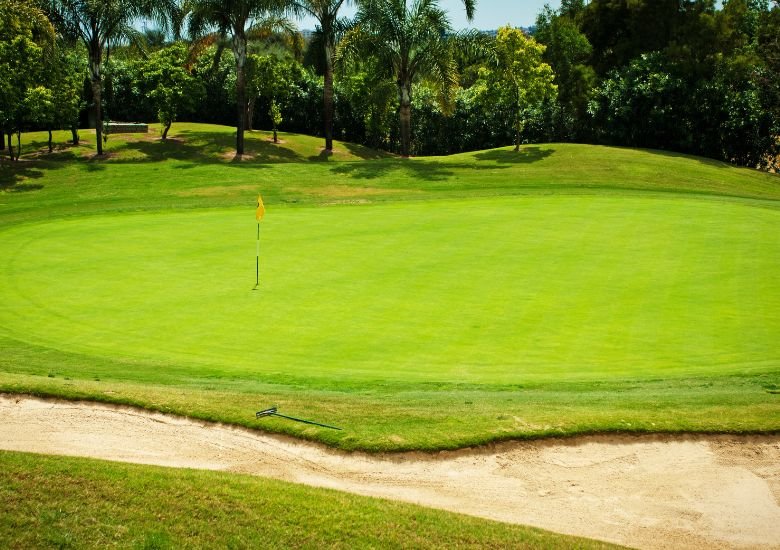The Green Revolution aims to address these issues head-on, transforming golf courses into ecological havens that benefit both players and the planet. A single round of golf on a traditional course can guzzle up to 300 gallons of water, equivalent to a family’s water usage for a week.
From water usage to chemical runoff, the industry has faced criticism for its ecological footprint. Let’s explore the driving forces behind this shift and how it’s creating a win-win situation for the environment, golfers, and communities.
Inside The Green Revolution in Sustainable Golf Course Construction
Sustainable Design Principles:
The Green Revolution starts with a shift in design philosophy. Instead, minimizing land disturbance respects existing ecosystems, incorporating natural features like wetlands and native vegetation into the course layout.

This not only preserves biodiversity but also reduces the need for maintenance and artificial interventions.
Water conservation is another cornerstone of sustainable design. Rainwater harvesting systems capture and store precious precipitation, while greywater irrigation utilizes treated wastewater for non-potable uses like watering rough areas.
Replacing thirsty turfgrasses with drought-resistant varieties further reduces water dependence, ensuring vibrant greens without stressing local water resources.
Integrated Pest Management (IPM) replaces harmful chemicals with natural methods like beneficial insects and targeted treatments. This approach protects golfers and the environment from harmful toxins while maintaining a healthy balance in the ecosystem.
Cutting-Edge Technologies:
Innovation plays a crucial role in the Green Revolution. Advanced irrigation systems use sensors and weather data to deliver water precisely where and when it’s needed, minimizing waste and maximizing efficiency.
Recycled materials and bio-based products find their way into construction, reducing reliance on virgin resources and lowering the carbon footprint of the course.
Renewable energy sources like solar panels and wind turbines power maintenance equipment and clubhouse operations, decreasing dependence on fossil fuels and contributing to a cleaner energy future.
Benefits for All Stakeholders:
Environmental Wins: Green construction employs drought-resistant native grasses, strategically placed water-harvesting systems, and efficient irrigation technology, slashing water consumption by up to 50%. These efforts also protect local water bodies by minimizing pollution from fertilizers and pesticides, thanks to a shift towards organic land management. This creates a healthier ecosystem for everyone, from the fish in the nearby stream to the golfers breathing fresh air.
Economic Advantages: Lower water bills, reduced chemical costs, and efficient resource management translate to significant savings for course owners. Additionally, studies show that environmentally conscious courses often see increased property values, attracting eco-conscious players and boosting local tourism. It’s a green investment with tangible returns.
Social Impact: By incorporating native plants and creating wildlife corridors, they become biodiversity havens, attracting birds, butterflies, and other creatures. This not only enhances the natural beauty of the course but also provides valuable recreational opportunities for nature lovers. Additionally, engaging with local communities through educational programs and volunteer initiatives fosters a sense of shared ownership and environmental responsibility.
Inspiring Case Studies:
The green revolution isn’t just a theoretical concept. Courses worldwide are embracing sustainable practices and reaping the rewards.
Take, for example, the Redstone Golf Club in Arizona. By using recycled water for irrigation and planting native desert grasses, they reduced water usage by 80%, saving millions of gallons annually. This water conservation not only benefits the environment but also allows the course to thrive in a water-scarce region.
Kingsbarns Golf Links in Scotland showcases another approach. They partnered with conservation organizations to restore native dunes and create wildlife habitats, transforming the course into a haven for endangered birds and other species. This commitment to biodiversity has earned them international recognition and attracted golfers seeking a unique and ecologically sensitive experience.
These are just two examples of the many inspiring stories unfolding on green courses around the globe. By quantifying the positive environmental and economic impact of these projects, we can see the undeniable power of sustainable construction.
Reduced water use, lower costs, and increased property values alongside enriched ecosystems and engaging communities paint a clear picture of success.
But how can you, as a golfer, be part of this revolution?
Choose Sustainable Courses:
Do your research: Look for courses with certifications like Audubon International or GEO Foundation, which recognize environmentally responsible practices.
Ask questions: When booking a tee time, inquire about the course’s water conservation efforts, use of native plants, and commitment to wildlife habitat protection.
Spread the word: Share your knowledge and preferences with fellow golfers, encouraging them to seek out sustainable courses.
By making informed choices and sharing your passion for sustainability, you can contribute to a healthier planet and a more enjoyable golfing experience for generations to come.
DTE Golf®: Your Partner in Sustainable Golf Course Construction
DTE Golf® understands the importance of sustainable practices. With over 30 years of experience, we offer a comprehensive suite of services designed to help courses achieve their sustainability goals. Our team of dedicated professionals uses innovative technologies and best practices to:
- Reduce water consumption
- Minimize chemical use
- Enhance soil health
- Promote biodiversity
- Optimize energy efficiency
We believe that sustainable golf course construction is not only good for the environment but also good for business.
By partnering with DTE Golf®, you can create a course that is beautiful, playable, and environmentally responsible, attracting players and enhancing your brand reputation.
Contact DTE Golf® today to learn more about how we can help you build a sustainable future for your course.
